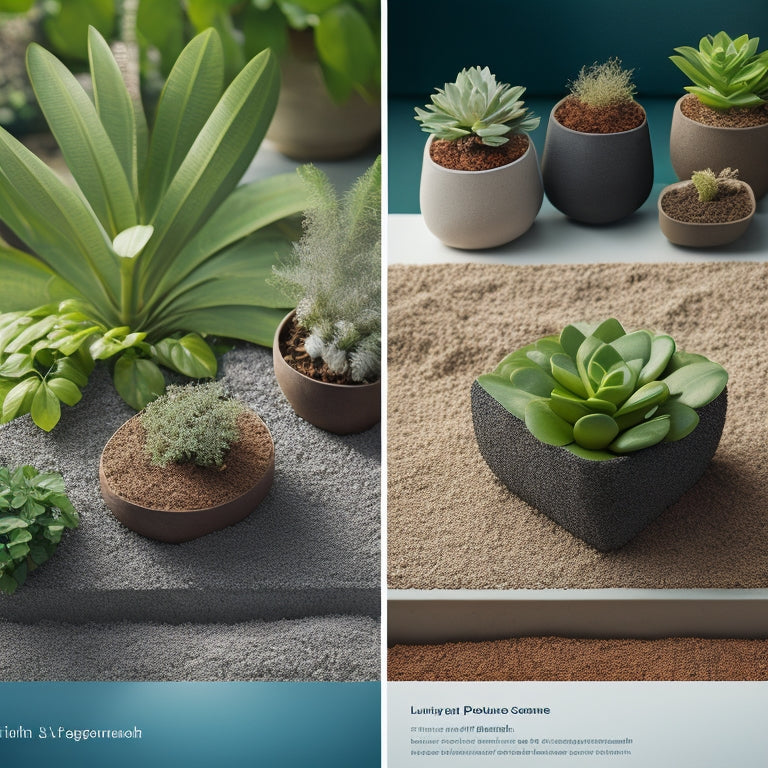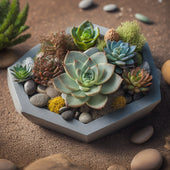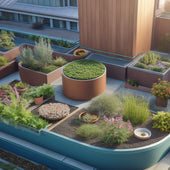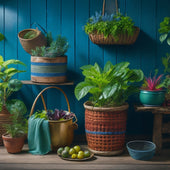
3 Best Drainage Materials for Block Planters
Share
When setting up your block planters, you need a reliable drainage system to prevent waterlogged soil and promote healthy plant growth. Three exceptional drainage materials can help you achieve this: porous clay pebbles, landscape fabric, and broken pottery. Porous clay pebbles allow excess water to seep through, improving airflow and oxygen availability for roots. Landscape fabric prevents soil erosion and clogged drainage holes, while broken pottery aids in airflow and prevents soil from washing away. By incorporating one of these materials, you'll be well on your way to creating a thriving environment for your plants - and you'll soon discover which one best suits your unique needs.
Key Takeaways
• Porous clay pebbles provide optimal moisture levels, preventing root rot and improving airflow for healthy plant growth.
• Landscape fabric prevents soil erosion, ensures smooth water flow, and supports healthier root systems in block planters.
• Broken pottery is an eco-friendly and cost-effective drainage solution that prevents clogging and promotes healthy root growth.
• A 1-2 inch layer of porous clay pebbles at the bottom of the planter is a recommended installation method for block planters.
• These three drainage materials can be used individually or in combination to create an effective drainage system in block planters.
Porous Clay Pebbles for Drainage
When selecting a drainage material for your block planters, consider using porous clay pebbles, which allow excess water to seep through their intricate network of tiny holes and air pockets. This unique structure provides several benefits, including improved airflow, reduced waterlogging, and increased oxygen availability for roots.
As a result, your plants will thrive in a healthy, well-draining environment.
To reap the benefits of porous clay pebbles, follow these installation tips: start by adding a 1-2 inch layer of pebbles at the bottom of your planter, making sure to cover the entire surface. This will create a reservoir for excess water to drain into.
Next, add a layer of soil on top of the pebbles, leaving enough space for your plants' roots to grow. Finally, plant your chosen species, and water thoroughly to settle the soil.
With porous clay pebbles, you can rest assured that your plants will receive the right amount of moisture, without waterlogging or root rot.
Landscape Fabric for Block Planters
Set landscape fabric at the bottom of your block planter to prevent soil from washing away and clogging drainage holes, ensuring a smooth flow of water and air to your plants' roots. This fabric installation is a simple yet effective way to reap landscape benefits, including improved drainage and reduced soil erosion.
By separating the soil from the drainage holes, the fabric allows water to flow freely, reducing the risk of waterlogged soil and root rot.
When installing landscape fabric, cut it to size and place it at the bottom of the planter, making sure to cover the entire surface. Secure it with rocks or gravel to prevent it from shifting.
Then, add your soil and plants, and enjoy the benefits of improved drainage and healthier roots. With landscape fabric, you can rest assured that your plants are receiving the right amount of water and air, leading to stronger growth and more vibrant blooms.
Broken Pottery for Drainage Solution
You can create a free-draining system in your block planter by incorporating broken pottery at the bottom, allowing excess water to escape while preventing soil from clogging the drainage holes. This simple yet effective solution is one of the most popular uses of broken pottery, and for good reason. By adding a layer of broken pottery, you can improve drainage efficiency and reduce the risk of waterlogged soil.
Here's a breakdown of the benefits of using broken pottery in your block planter:
| Broken Pottery Uses | Drainage Efficiency | Benefits |
|---|---|---|
| Prevents soil clogging | High | Reduces waterlogging risk |
| Allows excess water to escape | High | Improves plant health |
| Aids in airflow | Medium | Supports healthy root growth |
| Inexpensive and eco-friendly | High | Cost-effective and sustainable |
| Easy to install | High | Simplifies planter setup |
Frequently Asked Questions
Can I Use Regular Potting Soil in My Block Planters?
You're wondering if regular potting soil will cut it in your block planters. The short answer: it's not ideal.
Regular potting soil can retain too much water, leading to root rot and poor drainage. Instead, consider potting soil alternatives that prioritize drainage benefits, like mixes with perlite or vermiculite.
These additives improve air pockets and water flow, creating a healthier environment for your plants to thrive.
How Often Should I Clean Out My Block Planter's Drainage System?
Freshly flushed filters and faultless flow are your friends when it comes to block planter maintenance.
You should clean out your drainage system every 1-2 months to prevent pesky clogs and guarantee proper water flow.
Regular drainage maintenance is essential for clog prevention and healthy plant growth.
Make it a habit to inspect and clear your system frequently, and your plants will thank you with vibrant blooms and strong roots.
Are There Any Specific Block Planter Designs for Better Drainage?
When designing your block planter, you'll want to contemplate shapes and features that promote better drainage.
Look for planters with built-in drainage design features, such as tapered sides, raised bottoms, or angled channels that direct water away from the soil.
Round or oval block planter shapes can also improve drainage by allowing water to flow more easily.
Can I Mix Different Drainage Materials for Better Results?
You're wondering if combining different drainage materials can optimize performance. The answer is yes, but it's essential to understand the characteristics of each type.
You can mix porous materials like perlite or vermiculite with denser ones like gravel or broken pottery.
Experiment with layering techniques, such as placing coarse materials at the bottom and finer ones towards the top.
Do I Need to Add a Drainage Layer to the Bottom of My Planter?
When setting up your planter, you're wondering if adding a drainage layer to the bottom is necessary. The answer is yes!
This essential step guarantees excess water escapes, preventing waterlogged soil and root rot.
By doing so, you'll reap drainage benefits, like improved planter health and a reduced risk of disease.
Imagine a healthy, thriving plant, thanks to your proactive approach.
Conclusion
As you've read, selecting the right drainage material for your block planters is essential to prevent waterlogged soil and root rot.
Think of these materials as the unsung heroes of your garden, working behind the scenes to keep your plants thriving.
With porous clay pebbles, landscape fabric, and broken pottery, you've got a trio of effective solutions to keep excess water at bay, ensuring your plants receive just the right amount of moisture - like Goldilocks, not too little, not too much, but just right.
Related Posts
-

Why Succulents Thrive in DIY Concrete Planters
You've likely noticed that succulents seem to flourish in DIY concrete planters, and it's not just a coincidence - th...
-

Why Succulents Thrive in DIY Concrete Planters
You've likely noticed that succulents seem to flourish in DIY concrete planters, and it's not just a coincidence - th...
-

Why Succulents Thrive in DIY Concrete Planters
You've likely noticed that succulents seem to flourish in DIY concrete planters, and it's not just a coincidence - th...
-

Why Succulents Thrive in DIY Concrete Planters
You've likely noticed that succulents seem to flourish in DIY concrete planters, and it's not just a coincidence - th...
-

Why Succulents Thrive in DIY Concrete Planters
You've likely noticed that succulents seem to flourish in DIY concrete planters, and it's not just a coincidence - th...
-

Why Succulents Thrive in DIY Concrete Planters
You've likely noticed that succulents seem to flourish in DIY concrete planters, and it's not just a coincidence - th...
-

Why Succulents Thrive in DIY Concrete Planters
You've likely noticed that succulents seem to flourish in DIY concrete planters, and it's not just a coincidence - th...
-

Why Succulents Thrive in DIY Concrete Planters
You've likely noticed that succulents seem to flourish in DIY concrete planters, and it's not just a coincidence - th...
-

Why Succulents Thrive in DIY Concrete Planters
You've likely noticed that succulents seem to flourish in DIY concrete planters, and it's not just a coincidence - th...
-

Why Succulents Thrive in DIY Concrete Planters
You've likely noticed that succulents seem to flourish in DIY concrete planters, and it's not just a coincidence - th...
-

Why Succulents Thrive in DIY Concrete Planters
You've likely noticed that succulents seem to flourish in DIY concrete planters, and it's not just a coincidence - th...
-

Why Succulents Thrive in DIY Concrete Planters
You've likely noticed that succulents seem to flourish in DIY concrete planters, and it's not just a coincidence - th...
-

Why Succulents Thrive in DIY Concrete Planters
You've likely noticed that succulents seem to flourish in DIY concrete planters, and it's not just a coincidence - th...
-

Why Succulents Thrive in DIY Concrete Planters
You've likely noticed that succulents seem to flourish in DIY concrete planters, and it's not just a coincidence - th...
-

Why Succulents Thrive in DIY Concrete Planters
You've likely noticed that succulents seem to flourish in DIY concrete planters, and it's not just a coincidence - th...
-

Why Succulents Thrive in DIY Concrete Planters
You've likely noticed that succulents seem to flourish in DIY concrete planters, and it's not just a coincidence - th...
-

Why Succulents Thrive in DIY Concrete Planters
You've likely noticed that succulents seem to flourish in DIY concrete planters, and it's not just a coincidence - th...
-

3 Best Roof Garden Drainage Solutions for Planters
When designing your roof garden, you'll want to implement a planter drainage system that guarantees water flows freel...
-

3 Best Roof Garden Drainage Solutions for Planters
When designing your roof garden, you'll want to implement a planter drainage system that guarantees water flows freel...
-

3 Best Roof Garden Drainage Solutions for Planters
When designing your roof garden, you'll want to implement a planter drainage system that guarantees water flows freel...
-

3 Best Roof Garden Drainage Solutions for Planters
When designing your roof garden, you'll want to implement a planter drainage system that guarantees water flows freel...
-

3 Best Roof Garden Drainage Solutions for Planters
When designing your roof garden, you'll want to implement a planter drainage system that guarantees water flows freel...
-

3 Best Roof Garden Drainage Solutions for Planters
When designing your roof garden, you'll want to implement a planter drainage system that guarantees water flows freel...
-

3 Best Roof Garden Drainage Solutions for Planters
When designing your roof garden, you'll want to implement a planter drainage system that guarantees water flows freel...
-

3 Best Roof Garden Drainage Solutions for Planters
When designing your roof garden, you'll want to implement a planter drainage system that guarantees water flows freel...
-

3 Best Roof Garden Drainage Solutions for Planters
When designing your roof garden, you'll want to implement a planter drainage system that guarantees water flows freel...
-

3 Best Roof Garden Drainage Solutions for Planters
When designing your roof garden, you'll want to implement a planter drainage system that guarantees water flows freel...
-

3 Best Roof Garden Drainage Solutions for Planters
When designing your roof garden, you'll want to implement a planter drainage system that guarantees water flows freel...
-

3 Best Roof Garden Drainage Solutions for Planters
When designing your roof garden, you'll want to implement a planter drainage system that guarantees water flows freel...
-

3 Best Roof Garden Drainage Solutions for Planters
When designing your roof garden, you'll want to implement a planter drainage system that guarantees water flows freel...
-

7 Creative Upcycled Planter Tutorials to Try Now
Get ready to transform your outdoor space with these 7 creative upcycled planter tutorials! Start by turning cinder b...
-

7 Creative Upcycled Planter Tutorials to Try Now
Get ready to transform your outdoor space with these 7 creative upcycled planter tutorials! Start by turning cinder b...
-

7 Creative Upcycled Planter Tutorials to Try Now
Get ready to transform your outdoor space with these 7 creative upcycled planter tutorials! Start by turning cinder b...
-

7 Creative Upcycled Planter Tutorials to Try Now
Get ready to transform your outdoor space with these 7 creative upcycled planter tutorials! Start by turning cinder b...
-

7 Creative Upcycled Planter Tutorials to Try Now
Get ready to transform your outdoor space with these 7 creative upcycled planter tutorials! Start by turning cinder b...
-

7 Creative Upcycled Planter Tutorials to Try Now
Get ready to transform your outdoor space with these 7 creative upcycled planter tutorials! Start by turning cinder b...
-

7 Creative Upcycled Planter Tutorials to Try Now
Get ready to transform your outdoor space with these 7 creative upcycled planter tutorials! Start by turning cinder b...
-

7 Creative Upcycled Planter Tutorials to Try Now
Get ready to transform your outdoor space with these 7 creative upcycled planter tutorials! Start by turning cinder b...
-

7 Creative Upcycled Planter Tutorials to Try Now
Get ready to transform your outdoor space with these 7 creative upcycled planter tutorials! Start by turning cinder b...
-

7 Creative Upcycled Planter Tutorials to Try Now
Get ready to transform your outdoor space with these 7 creative upcycled planter tutorials! Start by turning cinder b...
-

7 Creative Upcycled Planter Tutorials to Try Now
Get ready to transform your outdoor space with these 7 creative upcycled planter tutorials! Start by turning cinder b...
-

7 Creative Upcycled Planter Tutorials to Try Now
Get ready to transform your outdoor space with these 7 creative upcycled planter tutorials! Start by turning cinder b...
-

7 Creative Upcycled Planter Tutorials to Try Now
Get ready to transform your outdoor space with these 7 creative upcycled planter tutorials! Start by turning cinder b...
-

7 Creative Upcycled Planter Tutorials to Try Now
Get ready to transform your outdoor space with these 7 creative upcycled planter tutorials! Start by turning cinder b...
-

7 Creative Upcycled Planter Tutorials to Try Now
Get ready to transform your outdoor space with these 7 creative upcycled planter tutorials! Start by turning cinder b...
-

7 Creative Upcycled Planter Tutorials to Try Now
Get ready to transform your outdoor space with these 7 creative upcycled planter tutorials! Start by turning cinder b...
-

7 Creative Upcycled Planter Tutorials to Try Now
Get ready to transform your outdoor space with these 7 creative upcycled planter tutorials! Start by turning cinder b...
-

7 Creative Upcycled Planter Tutorials to Try Now
Get ready to transform your outdoor space with these 7 creative upcycled planter tutorials! Start by turning cinder b...
-

7 Creative Upcycled Planter Tutorials to Try Now
Get ready to transform your outdoor space with these 7 creative upcycled planter tutorials! Start by turning cinder b...
-

7 Creative Upcycled Planter Tutorials to Try Now
Get ready to transform your outdoor space with these 7 creative upcycled planter tutorials! Start by turning cinder b...
-

7 Creative Upcycled Planter Tutorials to Try Now
Get ready to transform your outdoor space with these 7 creative upcycled planter tutorials! Start by turning cinder b...
-

7 Creative Upcycled Planter Tutorials to Try Now
Get ready to transform your outdoor space with these 7 creative upcycled planter tutorials! Start by turning cinder b...
-

7 Creative Upcycled Planter Tutorials to Try Now
Get ready to transform your outdoor space with these 7 creative upcycled planter tutorials! Start by turning cinder b...
-

7 Creative Upcycled Planter Tutorials to Try Now
Get ready to transform your outdoor space with these 7 creative upcycled planter tutorials! Start by turning cinder b...


